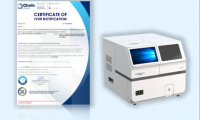-
The latest domestic innovative COVID-19 drug Taizhongding® is exclusively available on Meituan’s online drug shopping website
- Source: drugdu
- 103
- January 1, 2024
-
HANSIZHUANG Sets Sail in Indonesia Market
- Source: drugdu
- 353
- December 30, 2023
-
Organon pays $50M to pick up rights to pair of Eli Lilly migraine meds in Europe
- Source: drugdu
- 170
- December 30, 2023
-
AI Accurately Predicts Cancer Outcomes from Tissue Samples
- Source: drugdu
- 139
- December 29, 2023
-
Fosun Diagnostics’ Fully Automated Chemiluminescence Immunoassay Analyzer F-i1000 Obtains EU IVDR Certification
- Source: drugdu
- 105
- December 29, 2023
-
With FDA approval, Ionis and AstraZeneca gear up to launch rare disease drug Wainua
- Source: drugdu
- 222
- December 27, 2023
-
da Vinci Innovation & Training Center Celebrates its Second Anniversary
- Source: drugdu
- 105
- December 27, 2023
-
The AI Tool that Matters Most for Clinical Care Isn’t ChatGPT
- Source: drugdu
- 116
- December 25, 2023
-
Previously unrecognized class of antibodies can broadly neutralize multiple virus strains
- Source: drugdu
- 215
- December 25, 2023
-
Shanghai RAAS Cancels Limited Payment Scope of Medical Insurance for Some Products
- Source: drugdu
- 83
- December 25, 2023
your submission has already been received.
OK
Subscribe
Please enter a valid Email address!
Submit
The most relevant industry news & insight will be sent to you every two weeks.













